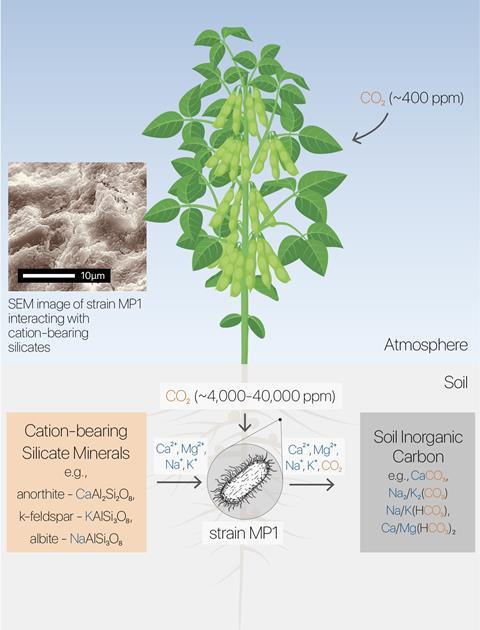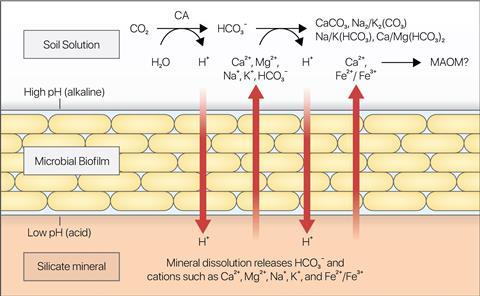Researchers have discovered that a common soil bacterium can turn ordinary farm fields into carbon-removal systems by accelerating the natural weathering of rocks already present in agricultural soils. The findings, based on laboratory assays, mesocosm experiments, and field trials across 847 hectares in North Dakota (USA), demonstrate that seed-applied Bacillus subtilis strain MP1 can lock away approximately 2 tonnes of inorganic carbon per hectare per year (or 7.3 tonnes of CO2), without requiring any changes to farming practices.
The discovery leverages Earth’s ancient silicate weathering process, which has regulated atmospheric CO2 levels for billions of years. When rainwater meets rock, chemical reactions occur that draw down carbon dioxide and convert it into bicarbonate and stable mineral forms. However, rain isn’t acting alone. The contribution of microorganisms and plants, which has been overlooked for decades, represents an essential factor in the silicate weathering process. MP1, applied in agricultural fields, is an example of microbes accelerating silicate weathering by approximately sixfold.
Harnessing the plant-microbe partnership for climate solutions
Unlike energy-intensive engineered carbon dioxide removal (CDR) approaches such as direct air capture (DAC), MP1 leverages the existing photosynthetic machinery of crops. This bacterial strain establishes a mutualistic relationship with plant roots, positioning itself at the critical interface where atmospheric carbon first enters the soil ecosystem.
The elegance of this system lies in part in its energy source. MP1 taps into the continuous flow of photosynthetic products from plant roots. As crops capture solar energy and convert it into chemical energy through photosynthesis, a portion of this energy becomes available to root-associated microorganisms through root exudates. While thriving in that highly nutritious niche, the rhizosphere, MP1 converts atmospheric CO₂ that diffuses into the soil into carbonate and bicarbonate compounds (i.e., soil inorganic carbon) that remain stable for thousands of years. This creates a direct pathway from atmospheric carbon to permanent geological storage, powered entirely by solar energy.
“What makes strain MP1 unique is its ability to efficiently intercept CO₂ in the rhizosphere and redirect it toward permanent carbon sequestration rather than allowing it to cycle back to the atmosphere”, explains the research team behind this breakthrough.

Biofilm-mediated weathering creates micro-scale carbon factories
Researchers have demonstrated that MP1, isolated from corn roots, accelerates the dissolution of feldspar and other silicate minerals naturally abundant in many agricultural soils. It does so by creating a biofilm with two distinct chemical zones separated by just micrometers. Within the biofilm interior, metabolic processes concentrate protons, creating acidic conditions that dissolve silicate minerals and release calcium, magnesium, and other cations along with alkalinity. Researchers hypothesize that this proton source originates from rapid CO₂ hydrolysis by carbonic anhydrase enzymes synthesized by the microbe. Outside the biofilm, at the biofilm-soil interface, the dissolving minerals, rich in alkalinity and cations, create alkaline conditions. These conditions promote the formation of carbonates and other secondary minerals, such as calcium carbonate and clays. The biogenic carbonates formed by MP1 serve as a reservoir of soil inorganic carbon (SIC), and, under favorable soil conditions (e.g., alkaline soils), represent a mechanism for long-term carbon storage.
Laboratory experiments validate the carbon mineralization pathway
Seven-day laboratory experiments, wherein the MP1 microbe was grown in the presence of silicate minerals, showed microbially mediated release of Ca2+ and Mg2+ from plagioclase feldspar. This release was associated with an upward shift in pH and increases in carbonate mineral formation, compared to controls without microbes. When researchers replaced feldspar with calcium or magnesium salts, carbonates increased similarly, confirming cation-enabled carbonate precipitation.
Mesocosm experiments confirm field-relevant carbon sequestration
Researchers also conducted a nine-week mesocosm study, which is a controlled indoor experiment that simulates natural conditions, using corn grown in columns packed with feldspar-rich field soil (40-45% of total soil weight). This experiment demonstrated approximately 20% higher soil inorganic carbon in MP1-treated soils compared to untreated control soils.
In addition to increases in soil inorganic carbon, key indicators of silicate weathering increased significantly, including:
- Exchangeable Ca2+, Mg2+, and Fe2+/Fe3+
- Cation exchange capacity (CEC), suggesting formation of secondary minerals
- Silicate weathering rates (approximately 6 times faster with MP1)
- Net CO2 removal (reaching 0.39 ± 0.06 tonnes of inorganic carbon per hectare)

Field trials deliver real-world validation at an agricultural scale
To test this approach at the field scale, MP1 was added with soybean seeds across 847 hectares in North Dakota (USA). The MP1 seed treatment was applied at a rate of approximately 5 million spores per seed using standard farm equipment, resulting in significant inorganic carbon formation and soil health benefits over the course of a growing season.
At the end of the growing season, the top ~30 cm of soil in the treated fields showed a 0.42% increase in SIC compared to the untreated fields. Using standard bulk density calculations, this equates to approximately 2.02 tonnes of inorganic carbon per hectare per year gross accrual.
In addition to increased carbon sequestration, the MP1 treatment was linked to several agronomic benefits, including:
- Enhanced soil health through increased cation exchange capacity and replenishment of exchangeable calcium
- pH buffering that countered seasonal soil acidification (+0.07 in MP1 vs -0.20 in control fields)
- Grain yield trended 7.5% higher, though not statistically significant in this study
- Better soil structure from increased carbonate mineral formation
- Sustained micronutrient levels for healthier crops
The researchers emphasize that the 2.02 tonnes of inorganic carbon per hectare figure represents gross accrual in an open field system. Some cations may derive from non-silicate sources, and carbonates can move vertically through soil profiles, something that could be addressed in the future by implementing reactive transport models taking into consideration the microbial contribution to silicate weathering.

Complementary to other soil-based CDR approaches
The application of MP1 in agricultural fields to remove CO2 through accelerated native silicate weathering is highly complementary to conventional regenerative agriculture practices that aim to increase soil organic matter and ultimately expand the soil organic carbon (SOC) pool. As silicate weathering proceeds and releases base cations (e.g., Ca2+, Mg2+), these ions can contribute to the formation of carbonate minerals in soil systems. Previous studies have demonstrated that carbonate minerals play a crucial role in stabilizing organic matter by acting as a physical barrier through aggregation and cementing. This synergy suggests that MP1 application could simultaneously support both inorganic carbon sequestration through the acceleration of native silicate weathering and SOC stabilization through carbonate mineral formation, creating a dual pathway for carbon storage that reinforces the soil health objectives central to regenerative agriculture.
Beyond its compatibility with regenerative agriculture practices, this approach of applying MP1 to agricultural systems rich in native cation-bearing silicates represents a viable pathway for carbon dioxide removal that can also complement other soil-based CDR technologies.
Another CDR approach that involves weathering silicates in agricultural settings is enhanced rock weathering (ERW). Despite these similarities, ERW is fundamentally distinct, as it involves spreading finely ground silicate rocks (e.g., basalt, olivine, or wollastonite) onto agricultural fields, rather than accelerating the weathering of silicate minerals already present in agricultural soils, as MP1 does. However, in certain situations, there could be potential co-benefits of combining MP1 with ERW. For instance, in soils where native cation-bearing silicate minerals have become depleted, periodic additions of crushed rock could replenish the mineral pool. Additionally, co-application could potentially amplify both weathering processes while supporting soil fertility and crop productivity.

Future challenges and research priorities
While the results described above point to a promising new CDR technology, there are areas requiring further investigation:
- Stability and fate of soil inorganic carbon: To better quantify the durability of carbon stored via microbially enhanced weathering, researchers should track the fate of new carbonates formed within the soil. Additional experimentation and soil biogeochemical modeling are two key tools for quantifying the persistence of inorganic carbon in the soil and its ultimate transport to rivers and oceans. This is also an open research question for other soil-mediated CDR technologies, such as ERW.
- Geographic optimization: Mapping regions with abundant native soil cation-bearing silicates and identifying the types of row crops that deliver optimal benefits when paired with MP1 are essential steps for identifying new areas suitable for this process.
Scalable implementation leveraging existing agricultural infrastructure
The approach’s immediate scalability stems from its compatibility with current farming systems. Agriculture already covers vast global areas, and farmers routinely use chemical seed treatments. MP1 is compatible with agricultural inputs, and its application requires no special equipment, no additional field passes, and no change of practices.
Millions of hectares of agricultural soil have CDR potential in the form of unweathered native cation-bearing silicates (e.g., feldspars). The researchers estimate that the CDR potential of suitable cropland globally is in the range of 187.2 to 316.4 GtCO2 when taking into account the first meter of the soil column. North Dakota alone has an estimated CDR potential of 4.8 GtCO2.
The discovery represents a practical convergence of microbiology and geology at an agricultural scale. While microbes have been involved for billions of years in Earth’s elemental cycling, this research demonstrates how to harness their geochemical capabilities to address the challenges of climate change.
As one researcher noted, “We are not asking farmers to become geologists. We’re letting their soils do what soils already do, just faster, and with a climate dividend.”
This research demonstrates microbially-mediated silicate weathering and carbon sequestration in agricultural systems. The complete methodology, peer review, and supplementary data are available in the full research publication.
References:
Use of Mineral Weathering Bacteria to Enhance Nutrient Availability in Crops: A Review | Frontiers
How Microorganisms Are Helping Farmers Capture Carbon | Forbes








No comments yet